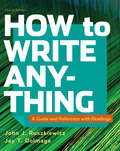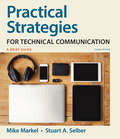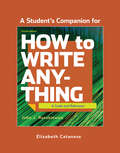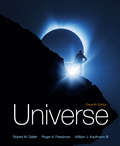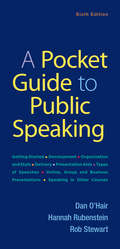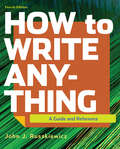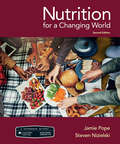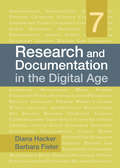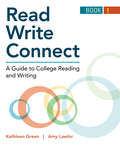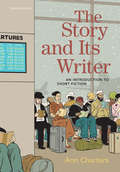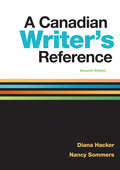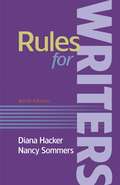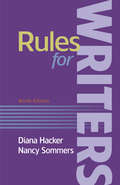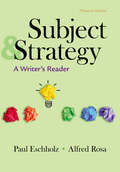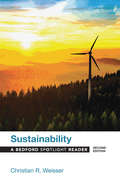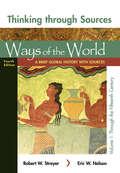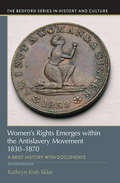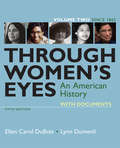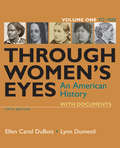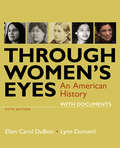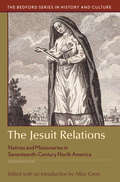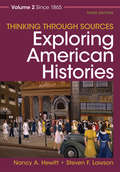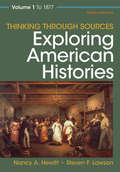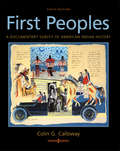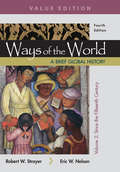Special Collections
Benetech’s Global Certified Accessible Titles
Description: Benetech’s GCA program is the first independent third-party EPUB certification to verify ebook accessibility. By creating content that is born accessible, publishers can meet the needs of all readers. Learn more: https://bornaccessible.benetech.org/
- Table View
- List View
How to Write Anything?
by John Ruszkiewicz and Jay DolmageInstructors at hundreds of colleges and universities have turned to How to Write Anything for clear, focused writing advice that gives students just what they need, when they need it. And students love it―because John Ruszkiewicz’s tone makes writing in any genre approachable, with a flexible, rhetorical framework for a range of common academic and real-world genres, and a reference with extra support for writing, research, design, style, and grammar.
Practical Strategies for Technical Communication
by Mike Markel and Stuart SelberThis brief version of Mike Markel's bestselling Technical Communication gives students clear advice and practical strategies for writing and designing all the major types of documents they will encounter in their professional lives. Retaining Markel's trademark student-friendly tone, the book offers concise yet thorough coverage of audience and purpose, research, style, and document design, user-friendly features to guide students in the writing process, and a wealth of annotated examples and sample documents to serve as models. Integrated coverage of social media and new technologies gives students the most up-to-date advice about technology in the context of specific tasks and documents. The print text is now integrated with e-Pages for Practical Strategies for Technical Communication, designed to take advantage of what the Web can do.
Universe
by Roger Freedman and Robert Geller and William KaufmannUniverse by Robert M. Geller and Roger Freedman strikes the right balance between scientific rigor, student comprehension, and excitement. Available as the full 27-chapter text or split into Stars and Galaxies and The Solar System, Universe provides all the detail you need to prepare students for engaging with astronomical ideas and theories, while also inviting students to explore through stunning visuals and relatable narratives.
A Pocket Guide to Public Speaking
by Dan O'Hair and Rob Stewart and Hannah RubensteinThis best-selling brief introduction to public speaking offers practical coverage of every topic typically covered in a full-sized text, from invention, research and organization, practice and delivery, to the different speech types. Its concise, inexpensive format makes it perfect not only for the public speaking course, but also for any setting across the curriculum, on the job, or in the community. The Sixth Edition is filled with new examples, research, handy tools, and digital support to help students master the basics of public speaking in the classroom and beyond. New speeches and examples from people like Will Ferrell, Emma Watson, and students from Marjory Stoneman Douglas High School engage students in current issues, demonstrate the impact of speech, and provide successful models. Practical advice on topics like how to determine which organizational pattern to use when, how to adapt to an audience, and how to incorporate inclusive language provide easy-to-apply guidance. The book’s LaunchPad has been greatly expanded with an eBook; new, professionally shot videos; unit quizzes; and a new video assessment program that makes recording video and providing instructor and peer feedback a breeze.
How to Write Anything
by John RuszkiewiczInstructors at hundreds of colleges and universities have turned to How to Write Anything for clear, focused writing advice that gives students just what they need, when they need it. And students love it―because John Ruszkiewicz’s tone makes writing in any genre approachable, with a flexible, rhetorical framework for a range of common academic and real-world genres, and a reference with extra support for writing, research, design, style, and grammar.
Scientific American: Nutrition for a Changing World
by Jamie Pope and Steve NizielskiNutrition for a Changing World engages students like no other nutrition textbook. Real stories – about real people and real science – are integrated into every chapter, bringing context and relevance to the core science. Infographics in the style of Scientific American magazine are like “science storyboards” that guide students step-by-step through essential processes and concepts. Coverage of timely topics such as gluten-free diets, the diabetes epidemic, and global nutrition exemplify the book’s contemporary approach to nutrition science. Nutrition for Changing World is also the only product for the course to offer automatically graded diet analysis activities. AnalyzeMyDiet provides both a diet tracker and personalized, auto-graded diet analysis activities built to cover a standard 3- to 7-day diet analysis assignment, freeing instructors from hand-grading these projects.
Research and Documentation in the Digital Age
by Diana Hacker and Barbara FisterWith advice for finding, evaluating, and documenting sources, this handy spiral-bound pocket guide covers the essential information college students need for research assignments in more than 30 disciplines. New, up-to-date documentation models guide students as they cite common sources and newer sources in the current editions of one of four documentation styles (MLA, APA, Chicago, and CSE). Advice, examples, and activities help students engage in the research process, find entry points in debates, and develop their authority as researchers. The many examples, according to one college librarian, “are realistic and relevant.” Research and Documentation in the Digital Age is the perfect companion to any college textbook.
Read, Write, Connect, Book 1
by Kathleen Green and Amy LawlorThe first text in a two-part series for the integrated reading and writing course, Read, Write, Connect, Book 1, offers carefully and thoroughly integrated instruction for reading and writing at the paragraph-to-essay level. With scaffolded pedagogy and a flexible structure that reflects the recursive nature of reading and writing processes, the text allows instructors to easily differentiate instruction to meet the needs of all students. It offers intensive practice in the basic skills of reading comprehension and summary writing, and then helps students build on those skills to respond to texts critically and analytically in their own college-level paragraphs and short essays. LaunchPad Solo for Readers and Writers can be packaged with Read, Write, Connect, Book 1 at no additional cost,, allowing you to more efficiently track students’ progress with reading, writing, and grammar skills in an active learning arc that complements the book.
The Story and Its Writer
by Ann ChartersAnn Charters has an acute sense of which stories work most effectively in the classroom and knows that writers, not editors, have the most interesting and useful things to say about the making and the meaning of fiction. Instructors look forward to every new edition of her bestselling anthology to see what stories her constant search for new fiction and neglected classics will turn up.
To complement the stories, Charters includes her signature innovation: an array of the writers’ own commentaries on the craft and traditions of fiction. The six Casebooks provide in-depth, illustrated studies of particular writers or genres, for unparalleled opportunities for discussion and writing. The new, trimmer, tenth edition features many very recent stories and commentaries by up-and-coming writers; a new Casebook on short shorts or flash fiction; and an expanded focus on why we read, study, and write about short fiction.
A Canadian Writer’s Reference
by Diana Hacker and Nancy SommersA Hacker handbook has always been a how-to manual for building confidence as a college writer. Diana Hacker conceived A Writer’s Reference as a quick-access innovation in handbook format, and Nancy Sommers continues to reinvent its content for an evolving course emphasizing critical reading and writing. For more than 20 years, the book has allowed students to build confidence and take ownership of their college writing experience.
A Canadian Writer’s Reference, and a variety of exciting digital options together represent a next-level tool for college writers. What’s most exciting? An emphasis on help that is personal, practical, and digital. A Canadian Writer’s Reference is reimagined as a system that helps students target their needs and see their successes; that offers innovative practice with writing, reading, thinking, and research; and that lives in an engaging multimedia environment.
Rules for Writers with Writing About Literature
by Diana Hacker and Nancy SommersBeginning college writers come from a wide range of backgrounds and communities. And for many, academic reading and writing skills are ones they must learn and practice. Enter Rules for Writers. It's an easy-to-use, comprehensive composition tool with the quality you expect from authors you trust. It empowers students by teaching them how to meet new expectations and by giving them the practice that builds confidence. With trusted advice for writing well, reading critically, and working with sources, Rules for Writers now has even more help for underprepared and inexperienced writers--sentence guides that foster an academic voice, tips for spotting fake news and misleading sources, more on paraphrasing, and fifteen new "how-to" pages that offer practical help for writing challenges. It's an affordable solution with significant value, especially when paired with LaunchPad Solo for Hacker Handbooks, an innovative practice solution available at no additional cost when package with a new text. With Rules for Writers, you're giving students more for their money, more ways to succeed, and more support than ever to help them meet the challenges of college writing--no matter what their background.
Rules for Writers
by Diana Hacker and Nancy SommersBeginning college writers come from a wide range of backgrounds and communities. And for many, academic reading and writing skills are ones they must learn and practice. Enter Rules for Writers. It's an easy-to-use, comprehensive composition tool with the quality you expect from authors you trust. It empowers students by teaching them how to meet new expectations and by giving them the practice that builds confidence. With trusted advice for writing well, reading critically, and working with sources, Rules for Writers now has even more help for underprepared and inexperienced writers--sentence guides that foster an academic voice, tips for spotting fake news and misleading sources, more on paraphrasing, and fifteen new "how-to" pages that offer practical help for writing challenges. It's an affordable solution with significant value, especially when paired with LaunchPad Solo for Hacker Handbooks, an innovative practice solution available at no additional cost when package with a new text.
Subject and Strategy
by Paul Eschholz and Al RosaConnecting reading and writing to the work students do in their other courses and to reading and writing in the workplace, Subject & Strategy goes beyond other rhetorical readers in the accessible writing instruction if offers at such an affordable price. This text provides the strategies your students need to approach any writing subject. With engaging readings, innovative classroom exercises, and effective writing assignments, Subject & Strategy guides students in selecting, practicing, and mastering writing strategies that will help them succeed in any discipline or career track they choose. Students are encouraged to see themselves as writers, and thorough coverage of reading and writing, research, documentation, and grammar provides a foundation for success.
Sustainability
by Christian R. WeisserSustainability explores questions around the central concept of sustainability: What are its foundations and politics? How do crises challenge sustainability? How is sustainability connected to local and transnational environments? How is sustainability connected to tourism and recreation? Readings by a range of ecologists, urban planners, philosophers, geographers, reporters, artists, and ordinary citizens take up these questions and more. Questions and assignments for each selection provide a range of activities for students. The website for the Spotlight Series offers comprehensive instructor support with sample syllabi and additional teaching resources. The Bedford Spotlight Reader Series is an exciting line of single-theme readers, each reflecting Bedford’s trademark care and quality. An editorial board of a dozen compositionists at schools with courses focusing on specific themes assists in the development of the series. Each reader collects thoughtfully chosen selections sufficient for an entire writing course—about 35 pieces—to allow instructors to provide carefully developed, high-quality instruction at an affordable price. Bedford Spotlight Readers are designed to help students from all majors make sustained inquiries from multiple perspectives, opening up topics such as money, food, border crossings, music, humor, subcultures, happiness, monsters, sustainability, and gender to critical analysis. The readers are flexibly arranged in thematic chapters, with each chapter focusing in depth on a different facet of the central topic. The website for the Spotlight Series offers comprehensive instructor support with sample syllabi and additional teaching resources.
Thinking Through Sources for Ways of the World, Volume 1
by Robert Strayer and Eric NelsonDesigned as a companion reader to accompany Ways of the World, each chapter of Thinking through Sources for Ways of the World contains a Thinking through Sources project of six to eight carefully selected written and visual primary sources organized around a particular theme, issue, or question. Each of these projects is followed by a related Historians’ Viewpoints secondary source feature, which pairs two brief excerpts from historians who comment on some aspect of the topics covered in the primary sources. Each source feature is accompanied by incisive questions to guide students’ skillful examination of the sources. Headnotes and questions to consider before each document help students approach the documents, and essay questions at the end of each chapter provide a starting point for classroom discussion or a written assignment. Thinking through Sources for Ways of the World is FREE when packaged with Ways of the World, and is included for FREE with ACHIEVE: Read and Practice, and in the LaunchPad for Ways of the World. In LaunchPad, innovative auto-graded exercises accompanying the Thinking through Sources projects supply a distinctive and sophisticated pedagogy that not only help students understand the sources but think critically about them. Thinking through Sources for Ways of the World is also available to customize through Bedford Select.
Women's Rights Emerges within the Anti-Slavery Movement
by Kathryn Kish SklarCombining documents with an interpretive essay, this book is the first to offer a much-needed guide to the emergence of the womens rights movement within the anti-slavery activism of the 1830s. The introductory essay places a new focus on the relationship among campaigns against racial prejudice and the emergence of the women’s rights movement, tracing the cause of women’s rights from Angelina and Sarah Grimkés campaign against slavery and the emergence of race as a divisive issue that finally split that movement in 1869. A rich collection of nearly 60 documents—10 of them new--includes a range of voices, from free black women activists such as Francis Watkins Harper and Sarah Mapps Douglass, to Quaker abolitionists and their opponents. Document headnotes, maps and illustrations, a chronology, questions for consideration, a selected bibliography, and an index have been updated and enrich students understanding of this period.
Through Women’s Eyes
by Lynn Dumenil and Ellen DuBoisThrough Women’s Eyes: An American History with Documents was the first text to present a narrative of U.S. women’s history within the context of the central developments of the United States and to combine this core narrative with written and visual primary sources in each chapter. The authors’ commitment to highlighting the best and most current scholarship, along with their focus on women from a broad range of ethnicities, classes, religions, and regions, has helped students really understand U.S. history Through Women’s Eyes.
Through Women’s Eyes
by Lynn Dumenil and Ellen DuBoisThrough Women’s Eyes: An American History with Documents was the first text to present a narrative of U.S. women’s history within the context of the central developments of the United States and to combine this core narrative with written and visual primary sources in each chapter. The authors’ commitment to highlighting the best and most current scholarship, along with their focus on women from a broad range of ethnicities, classes, religions, and regions, has helped students really understand U.S. history Through Women’s Eyes.
Through Women’s Eyes
by Lynn Dumenil and Ellen DuBoisThrough Women’s Eyes: An American History with Documents was the first text to present a narrative of U.S. women’s history within the context of the central developments of the United States and to combine this core narrative with written and visual primary sources in each chapter. The authors’ commitment to highlighting the best and most current scholarship, along with their focus on women from a broad range of ethnicities, classes, religions, and regions, has helped students really understand U.S. history Through Women’s Eyes.
The Jesuit Relations
by Allan GreerAs a 73-volume library, the original The Jesuit Relations has long been inaccessible to undergraduate students. Vitally important, the writings of seventeenth-century French Jesuits in Native North America tell the story of early American encounters. This new edition deftly binds them into a thematically arranged, 35-document sampler with a detailed introduction that provides background on these missionaries, the Indians, and their cohabitation in early North America. Colorful journal entries by such fathers as Paul LeJeune, Jean de Brébeuf, Isaac Jogues, and Jacques Marquette describe the Huron, Algonquin, Iroquois, and Montagnais peoples. Eleven images, two maps, a chronology, a bibliography, and questions for consideration supplement these firsthand accounts.
Thinking Through Sources for Exploring American Histories Volume 2
by Nancy Hewitt and Steven LawsonThinking through Sources for Exploring American Histories is a two-volume primary sources reader that supplements the document projects in the textbook. Each chapter of the reader presents five carefully selected documents that connect to topics in each chapter of Exploring American Histories. New Central Questions at the beginning of each chapter provide a framework and a focus for the documents that follow. Headnotes placed strategically before each document give students just enough context, and Interpret the Evidence and Put It in Context questions at the end of each chapter provide a starting point for classroom discussion or a written assignment. This collection of sources is available both in print and in LaunchPad with innovative auto-graded assessment.
Thinking Through Sources for Exploring American Histories Volume 1
by Nancy Hewitt and Steven LawsonThinking through Sources for Exploring American Histories is a two-volume primary sources reader that supplements the document projects in the textbook. Each chapter of the reader presents five carefully selected documents that connect to topics in each chapter of Exploring American Histories. New Central Questions at the beginning of each chapter provide a framework and a focus for the documents that follow. Headnotes placed strategically before each document give students just enough context, and Interpret the Evidence and Put It in Context questions at the end of each chapter provide a starting point for classroom discussion or a written assignment. This collection of sources is available both in print and in LaunchPad with innovative auto-graded assessment.
First Peoples
by Colin CallowayExpertly authored by Colin G. Calloway, First Peoples has been praised for its inclusion of Native American sources and Calloway’s concerted effort to weave Native perspectives throughout the narrative. Emphasizing the importance of primary sources, each chapter includes a document project and picture essay organized around important themes in the chapter. This distinctive approach continues to make First Peoples the bestselling and most highly acclaimed text for the American Indian history survey.
Ways of the World, Volume 2
by Robert W. Strayer and Eric W. NelsonWays of the World is one of the most successful and innovative textbooks for world history. The brief-by-design narrative is truly global and focuses on significant historical trends, themes, and developments in world history. Authors Robert W. Strayer, a pioneer in the world history movement with years of classroom experience, along with new co-author Eric W. Nelson, a popular and skilled teacher, provide a thoughtful and insightful synthesis that helps students see the big picture while teaching students to consider the evidence the way historians do.
